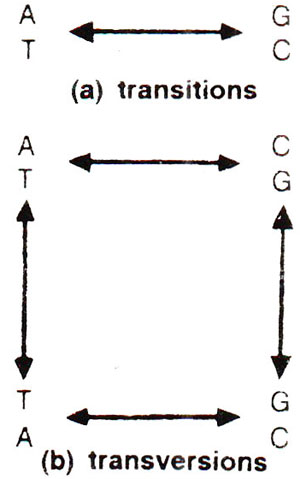Mutations and nucleotide sequences in nucleic acid
Mutations at molecular level, should mean permanent alterations in sequences of nucleotides (bases) in the nucleic acid, which forms the genetic material. These alterations in base sequences may be of the following types : (i) deletion of bases, (ii) insertion of bases, (iii) inversion of a sequence, and (iv) replacement of a base pair. Deletions, insertions and inversions include those changes in base sequences which involve breakage and reunion of DNA segments. However, replacement of a base pair may take place during replication of DNA without any breakage of DNA. These base pair replacements can be of two types, transitions and transversions. (i) Transitions are those base pair replacements, where a purine is replaced by another purine and a pyrimidine is replaced by another pyrimidine. It means that AT is replaced by GC and vice versa, (ii) Similarly transversions are those base replacements where a purine is replaced by a pyrimidine and vice versa. It means that CG can be replaced by GC and vice versa and similarly AT can be replaced by TA and vice versa. Similar changes can also take place between TA and GC as well as between AT and CG in bolh directions.
The base pair changes involved in transitions and transversions are diagrammatically represented in Figure 23.1. These changes take place due to mistakes in the incorporation of nucleic acid precursors or due to mistakes committed during replication. However, it is realized that among two types of base replacements, transitions are more frequent than transversions.





